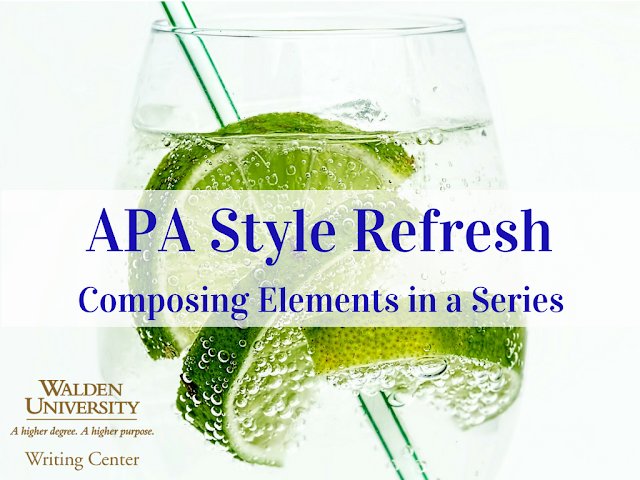APA Refresh: Foreign Titles
As Walden University is a global university, sometimes in
your research you may come across an article or book that has been translated
into English. To best help readers find the original article, APA style asks
researchers to include both the foreign title and the translated title into
English. What does this look like? Read on for an example!
If you are citing a foreign journal article (or book) that
has been translated, provide the original title in your reference as well as
the translation of the title into English in brackets.
Example:
Vergauwen, J., Neels, K., & Wood, J. (2016). Impact de
la situation économique sur la mise en couple en France (1993-2008)
[Educational differentials in the impact of micro- and macro-level economic
conditions on union formation in France (1993-2008)]. Population, 71(4),
593-617. doi:10.3917/pope.1604.0593
References
American
Psychological Association. (2010). Publication manual of the American
Psychological Association (6th ed.). Washington, DC: Author.
Hume-Pratuch, J.
(2012, Dec. 6). Citing translated sources in APA style. Retrieved from http://blog.apastyle.org/apastyle/2012/12/citing-translated-works-in-apa-style.html
Claire Helakoski is a writing instructor at the Walden Writing Center. Claire also co-hosts WriteCast, the Writing Center's podcast. Through these multi-modal avenues, Claire delivers innovative and inspiring writing instruction to Walden students around the world.
.png)
Never miss a new post; Opt-out at any time
August Webinar Preview
Here in the Writing Center, we love hosting webinars to share writing and APA style tips and tricks with all of you! Join us for one of our many live, interactive Writing Center webinars in August.Webinar Calendar
| Title: | Engaging Your Reader with Sentence Structure |
| Date: | Wednesday, July 25, 2018 |
| Time (Eastern): | 7:00PM - 8:00PM |
| Audience: | All Students |
| Title: | APA Citations Part 2: Nontraditional Sources |
| Date: | Thursday, August 2, 2018 |
| Time (Eastern): | 8:00PM - 9:00PM |
| Audience: | All Students |
| Title: | Beginnings and Endings: Introduce and Conclude Your Writing |
| Date: | Tuesday, August 7, 2018 |
| Time (Eastern): | 7:00PM - 8:00PM |
| Audience: | All Students |
| Title: | Grammar for Academic Writers: Identifying Common Errors |
| Date: | Tuesday, August 14, 2018 |
| Time (Eastern): | 12:00PM - 1:00PM |
| Audience: | All Students |
| Title: | Using Restorative Writing to Enact Social Change |
| Date: | Wednesday, August 15, 2018 |
| Time (Eastern): | 12:00PM - 1:00PM |
| Audience: | All Students |
| Title: | Practical Skills: Paraphrasing Source Information |
| Date: | Thursday, August 23, 2018 |
| Time (Eastern): | 1:00PM - 2:00PM |
| Audience: | All Students |
| Title: | Life Cycle of a Paper |
| Date: | Tuesday, August 28, 2018 |
| Time (Eastern): | 7:00PM - 8:00PM |
| Audience: | All Students |
Can't make it to one of our live webinars? No worries! We record all of our webinars and publish them in our webinar archive for you to view at your convenience.

The Walden University Writing Center produces a live webinar each and every week. Walden University students are encouraged to participate and practice their scholarly writing skills with one of our instructors or editors.
.png)
Never miss a new post; Opt-out at any time
APA Style Refresh: Composing Elements in a Series
When I consult the Publication Manual of the American Psychological Association (let’s call it The APA Manual from here) it’s usually not for mastering the correct formatting for title pages, making sure I have the comma in the correct location in my reference entries, or listing the correct terminology for a figure or a table. Instead, I am curious about the style recommendations that help readers follow along with the ideas being presented. The style recommendations throughout The APA Manual are indispensable, helpful, and thoughtful.Perhaps the most-common recommendation I make to writers using APA style in their scholarly writing is to check out Section 3.23 in The APA Manual: The section on writing elements in a series. According to this section, elements in a series should be presented parallel to enhance readers’ ease of comprehension. In other words, each element in the series should be constructed using the same word forms and sentence structures.
A series, also known as a list, is comprised of three or more elements. It’s important to format the elements coherently because it helps the reader focus on the ideas being presented. When readers can move through a series with ease, it is more likely that they will focus on the content of the list, which is the goal of the scholarly writer. However, if readers’ comprehension is muddled and they must slow down to parse a series, their focus strays from the meaning.
Let’s take a look at this sample series and break down how I constructed each element in the series:
The steps for replacing siding on one’s garage are to remove deteriorated boards, to insert new boards into place, to nail or screw boards to the studs of the garage wall, and to hope that nothing terrible happens in the process.
The first thing to notice is where each element of the series begins and ends. In this case, each step to replacing siding on a garage begins with “to.” This is a helpful cue to readers because they know immediately when the next step is beginning in the sentence.
Also notice the form of the verb and where it comes in the element. All of the verbs (“remove” “insert” “nail” and “hope”) immediately follow “to” and are conjugated using the same verb form. This is another way to help guide your reader through your series. Changing word orders, word forms, and word tenses is a surefire way to complicate your sentence and make your reader strain to understand your meaning.
A final, important tip is to separate each element in the series with a comma. Yes, APA style favors the serial comma (also known as the Oxford Comma) because it contributes to clearer communication between writer and reader. One little comma can make the difference between a reader fully understanding what each element in your list is doing and being confused where the final element of the series begins.
As you continue to develop and practice your scholarly writing skills, I recommend that you embrace the rigidity of The APA Manual’s recommendations for writing a series. Once you have developed strong control over writing complex sentences like this, then you can start to experiment with sentences that are written using near-parallel structure. In a near-parallel list, you may tweak small elements of the elements of your series to add some variety for the reader. However, these are extremely tricky to do well, and I recommend you practice the basics first.
Here are some sentences containing series that are written in non-parallel ways. I challenge you, dear reader. Can you rewrite one or all of these sentences in the comments box below so they adhere to parallel construction?
The dog’s favorite activities are fetching the ball, the stick, and running around chasing butterflies.
I love all of the items that I harvest from my garden but I especially love the green beans, the way they taste better than the summer squashes, and harvesting kale by the armload.
To become a better writer, according to my Writing Instructor, I need to work on crafting parallel lists, evidence, and when I consult the Writing Center’s resources, I need to pay attention to the details.
I can’t wait to see what you come up with!
Max Philbrook is a writing instructor and the coordinator of social media resources at the Walden Writing Center. He believes in the power of APA style to provide structure and guidance for scholarly writers at all levels. Max's favorite summer pastimes are swimming, harvesting produce in the garden, and throwing a ball for Zoie the dog.
.png)
Never miss a new post; Opt-out at any time
APA Style Refresh: Citing Multiple Sources to a Single Point
Join us for a new blog feature where we give our readers, students, and scholarly writers an APA Refresh. These posts will help you to understand the common (and some not-so-common) APA rules, guidelines, and style considerations. We hope you find them informative and helpful. Just like a cold beverage on a hot, hot day, you'll definitely enjoy this APA Refresh!
The more sources students read in their field of study, the more it becomes apparent that some scholars advance similar claims and or argue similar points. In fact, you might have even noticed that some scholars, in their work, attribute more than one source for a point to reflect this. As well, the further along you are in your studies, such as working on a literature review, a thesis, or a doctoral capstone study or dissertation, the more likely it will be that you will attribute more than one source to a point. So, how do you do this per APA style? In this post, I will provide an overview of how to attribute multiple sources to a single point.
Citation Basics
First, let's begin with some citation basics. If I want to attribute several authors to the same point, I have two choices, right? I can either use a narrative citation, where the sources are part of the grammatical structure of the sentence, or I can cite them parenthetically, where the sources are in parenthesis at the end of the sentence. When I read a work that attributes several different authors to the same point using a narrative citation format, I tend to find it more difficult to focus on the point of the sentence since more focus is placed on attributing different authors to the point.
Here is an example of a narrative citation that attributes several authors to the same point:
Philbrook (2018), Read (2018), Sharpe (2018), and Townsend (2018) noted that citing several authors in a parenthetical citation can complicate the clarity of a point.
While this is correct APA format, I find reading this sentence somewhat hard because there are so many authors listed that the point itself seems drowned out. If you do want to include the authors as part of a narrative citation, though, you can see that the basic format would be the same as other narrative citations except for each source is separated by a comma.
Use Parenthetical Citations to Cite Multiple Sources
That said, let’s look as some examples of how to parenthetically attribute more than one source to a point. Let’s say that the authors Steve Adams, Annika Jones, and Raul Smith all made the point that spicy food is healthy and should be consumed regularly (I agree!).
The basic format for parenthetically citing more than one source for a point is to separate the sources by semi-colons. Here is an example of the basic format for attributing more than one author to a single (paraphrased) point:
Spicy food is healthy and should be consumed regularly (Adams, 2016; Jones, 2011; Smith, 2018).
Seems fairly easy, right? Here, I included semi-colons to separate the sources—other than this, the citation format is the same as basic parenthetical citation format.
However, there are some variations for attributing more than one source to a point depending on the sources you are working with.
Variations for Citing Two or More Source for a Single Point
When there are two or more sources included by the same author, the sources would be listed by the order of the publication date with the author’s name included only once and the dates separated by a comma.
Example: Spicy food is healthy and should be consumed regularly (Adams, 2016, 2018; Jones, 2011, 2014; Smith, 2018).
In this example, Adams and Jones made this same point in two of their separate works, so the early dates of publication are included before the later dates. For instance, Adams’ 2016 work comes before Adams’ 2018 work, but I don’t need to include “Adams” twice; I just need to separate this author’s two sources by a comma.
Yet another format variation for attributing more than one source to a point is when there are two or more works included by the same author with the same date of publication. In this case, sources would be included in alphabetical order according to the lettered suffix (a, b, c, etc.).
Example: Spicy food is healthy and should be consumed regularly (Adams, 2016, 2018; Jones, 2011, 2014; Smith, 2018a, 2018b).
So here, Smith made the point in two separate works, both published in 2018. I included a lower-case letter, beginning with “a,” to differentiate these two sources with the same date of publication.
Learn more about citation variations on our website. Let us know, too, what citation variations you find difficult, confusing, or are just not sure about—we’re happy to help.
WriteCast Episode 52: Transitioning from Master's-Level to Doctoral-Level Writing
Making the move from master's to doctoral student can be surprising and challenging in terms of writing expectations. Max and Claire sit down to talk with Dr. Veronica Oliver, Writing Center writing instructor, about her transition and how students can prepare for their own.
Check out our episode preview!
Stream or download (via the Share button) the full episode:
Visit the Writing Center's WriteCast page for our episode archive and transcripts. Happy listening!
Writing Resources Recommended In This Episode
- Writing Process for Longer Projects live webinar recording
- Paper Review Appointment web page to learn about our one-on-one writing support for Walden University students
- Doctoral Capstone Form and Style section of our web page
- Finding sample dissertation/capstone documents in the Walden Library
WriteCast: A Casual Conversation for Serious Writers is a monthly podcast written, produced, and published by staff in the Walden University Writing Center. Join us each month for a dialogue between two Walden U writing instructors. Possible episode topics will always be considered from listeners--share your questions and suggestions in the comments.
.png)
Never miss a new post; Opt-out at any time
APA Style Refresh: Suffixes
Join us for a new blog feature where we give our readers, students, and scholarly writers an APA Refresh. These posts will help you to understand the common (and some not-so-common) APA rules, guidelines, and style considerations. We hope you find them informative and helpful. Just like a cold beverage on a hot, hot day, you'll definitely enjoy this APA Refresh!
When formatting essays in APA style, you may already know the basics of document formatting and how to use in-text citation. If not, I highly recommend a visit to our Writing Center resources for APA style. Even if you already know what to include in a parenthetical citation and how to format authors’ names in the reference list, there are some nuances in APA formatting that can cause problems even for seasoned users of APA style. For example, how should a writer format author names that include suffixes such as “Sr.” or “Jr.”?
According to the APA Style blog, while suffixes are set off by commas and included in the reference list, suffixes should not be included in in-text citations. Whether author Jane Doe is a “Jr.” or “III” or just plain Jane Doe, the only time a writer will use a suffix in conjunction with an author name is in the reference list. You can see a couple of examples illustrating how a writer might cite a work by Jane Elizabeth Doe, Sr., below:
Example in-text citation:
Doe (2016) lamented the nitpicky nature of APA formatting.
Example reference list entry:
Doe, J. E., Sr. (2016). Why does my suffix have to make everything so difficult? The Journal of Nitpicky APA Rules, 22, 6-46. doi:24.5297.t64364
Putting aside the fact that I wouldn’t want to read a 40-page article from a journal titled The Journal of Nitpicky APA Rules, using suffixes in APA isn’t so difficult. Even so, it can be helpful to review some of the more obscure APA rules occasionally. If you find these rules as difficult to remember as I do, the Walden University Writing Center blog team is here to help!
Katherine McKinney is a writing instructor in the Walden University Writing Center. She received an M.A. in English from Valdosta State University in Valdosta, Georgia, and is currently pursuing a Ph.D. in Education at Walden. Katherine's goal as an instructor is to show students that the best writing results from practice, and she aims to provide feedback and resources that will guide students through the invention, composition, and revision process.
.png)
Never miss a new post; Opt-out at any time
Narrative Writing Series: Tips from Creative Writers
Creating a narrative is common when writing fiction, personal essays, memoir, and other forms of non-academic writing. However, sometimes student writers are asked to create narratives. These personal reflections allow you to share your experiences, wisdom, and insight, but they can feel complicated to write as they seem to live in between scholarly academic writing and creative narrative writing.To help you with personal reflections, and to show you how narrative writing can be woven in other academic writing contexts, we created a narrative writing four-part blog series. The posts include:
- Narrative Writing Overview: Learn the definition of the form and general tips for writing personal reflections.
- Narrative Writing for Capstone Projects: These documents often require students to conduct and reflect on original research or project studies. Lydia shares strategies for including narration within the guidelines of capstone projects.
- APA Documentation in Narrative Writing: If your narrative includes an interview with someone, you will want to cite that. Even when writing narratives, student writers should adhere to APA-style guidelines.
- Including Relevant Details in Narrative Writing: When sharing a personal experience, it can be difficult to have to leave details out. In this post, Claire shares tips for choosing which details to include in your narrative.

The Walden Writing Center provides information and assistance to students with services like live chat, webinars, course visits, paper reviews, podcasts, modules, and the writing center webpages. Through these services they provide students assistance with APA, scholarly writing, and help students gain skills and confidence to enhance their scholarly work.
.png)
Never miss a new post; Opt-out at any time
Catch Your Reader's Ear: Simple Scholarly Voice Fixes
Note: This post has been updated per APA 7.Scholarly voice is an important component of APA Style which involves being clear, precise, and formal in tone. If you’re worried your voice may not be scholarly or want to do some quick checks through your work, here are some fast tips and fixes.
If you feel lost regarding what scholarly voice looks or sounds like, re-read your course materials! Reading peer-reviewed journal articles can help you hear and see what scholarly tone looks like in your particular discipline. Look back over your course readings to get a feel for that tone. You might find it helpful to read aloud and/or circle/highlight areas which seem scholarly to you as you read.
Once you feel you understand how scholarly tone may sound in your discipline, read your draft aloud. Listen to how your work sounds. Do you stumble over a complex sentence or lose your train of thought? Do you find yourself saying something a little differently than you wrote it? These can be good indicators of clunky work. Additionally, do you hear your work sounding informal or casual? Do you hear shifts in tone or voice—whether this is the types of words you’re using or sentence structure? These are great ways to find places to revise for clear, direct writing that works towards scholarly voice.
As you read aloud, keep your eyes open for some of these patterns that make your writing sound less than scholarly. Once you get the hang of it, these patterns are easy to spot and easy to fix. It just takes some practice!
Adverbs
Adverbs (like "interestingly," "clearly," "ideally") are unnecessary qualifiers you’re placing in your work and don’t enhance meaning but instead highlight how you’d like the reader to feel. By revising to remove these adverbs, you streamline your work and create an objective scholarly tone.
Casual Language
Some common casual language might be phrasing like “a lot,” “sort of,” “very,” “really,” “just like” or other qualifiers (see again suggestion 1).
Lack of Specificity
As a writer in the social sciences, being precise and specific is important so your reader knows exactly what you’re writing about. Instead of writing “you” or “they,” for example, replace those terms with the specific population you mean. Replace “it” and “things” whenever possible with the more specific term.
Expressions
APA states to be as literal as possible and avoid expressive language. Some expressions might be “shines a light on”, “on the other hand”, “in the light of day”. All of these are perfectly fine expressions in conversation, but they aren’t compliant with scholarly tone because there aren’t literal lights, changes in the time of day, or two hands. Ask yourself if you’re being literal in your descriptions and explanations, and revise if not.
With these quick revision strategies, you can work towards revising for and achieving scholarly voice in your writing! For more on scholarly voice, review our scholarly voice webpages, our Use of First Person and Avoiding Bias webinar, and our APA Style modules.
Claire Helakoski is a Writing Instructor at the Walden Writing Center and hosts the Writing Center's podcast, WriteCast. Claire holds an MFA in Creative Writing. She has taught writing and Composition as well as acted as a writer and editor in a variety of mediums. She lives in Grand Rapids, Michigan, and enjoys reading, writing creatively, and board games of all kinds.
.png)
Never miss a new post; Opt-out at any time
Subscribe to:
Posts
(
Atom
)















No comments :
Post a Comment